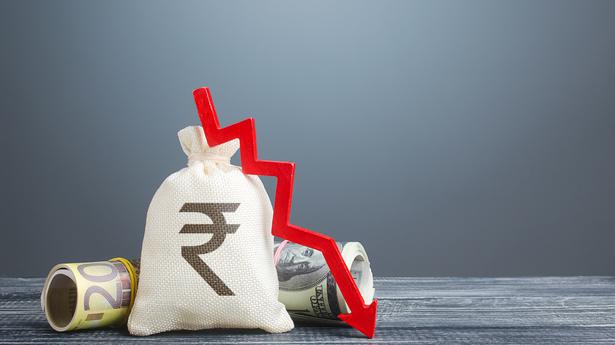
Explainer | The free fall of the rupee
The Hindu
Why are countries increasing their interest rates? What are the ways in which the RBI has tried to cushion the fall of the rupee?
The story so far: The Indian rupee hit an all-time low against the U.S. dollar this week weakening past the 79 rupees to a dollar mark and selling as low as 79.05 against the dollar on Wednesday. Many analysts expect the rupee to weaken further in the coming months and move past the 80 rupees to a dollar mark. In fact, the International Monetary Fund (IMF) expects the rupee to weaken past the 94 rupees to a dollar mark by FY29.
The Indian rupee has been witnessing a steady decline this year, losing more than 6% against the U.S. dollar since the beginning of 2022. India’s forex reserves have also dropped below $600 billion, plunging by more than $50 billion since September 3, 2021, when forex reserves stood at an all-time high of $642 billion. The drop in India’s forex reserves is believed to be largely due to steps taken by the Reserve Bank of India to support the rupee. RBI officials, however, have noted that the drop in forex reserves is due to a fall in the dollar value of assets held as reserves by the RBI. For instance, if a portion of the reserves are in euros and the euro depreciates against the dollar, this would cause a drop in the value of forex reserves.
It should be noted that, as a matter of policy, the Indian central bank has usually tried to slow down or smoothen, rather than reverse or prevent, the fall in exchange value of the rupee against the U.S. dollar. The aim of the RBI’s policy is to allow the rupee to find its natural value in the market but without undue volatility or causing unnecessary panic among investors. State-run banks are usually instructed by the RBI to sell dollars in order to offer some support to the rupee.
By thus selling dollars in the open market in exchange for rupees, the RBI can improve demand for the rupee and cushion its fall.
The value of any currency is determined by demand for the currency as well as its supply. When the supply of a currency increases, its value drops. On the other hand, when the demand for a currency increases, its value rises. In the wider economy, central banks determine the supply of currencies, while the demand for currencies depends on the amount of goods and services produced in the economy.
In the forex market, the supply of rupees is determined by the demand for imports and various foreign assets. So, if there is high demand to import oil, it can lead to an increase in the supply of rupees in the forex market and cause the rupee’s value to drop. The demand for rupees in the forex market, on the other hand, depends on foreign demand for Indian exports and other domestic assets. So, for instance, when there is great enthusiasm among foreign investors to invest in India, it can lead to an increase in the supply of dollars in the forex market which in turn causes the rupee’s value to rise against the dollar.
Since March this year, the U.S. Federal Reserve has been raising its benchmark interest rate causing investors seeking higher returns to pull capital away from emerging markets such as India and back into the U.S. This, in turn, has put pressure on emerging market currencies which have depreciated significantly against the U.S. dollar so far this year. Even developed market currencies such as the euro and the yen have depreciated against the dollar and the dollar index is up more than 9% so far this year. In fact, some analysts believe that the RBI’s surprise decision to raise rates in May could have simply been to defend the rupee by preventing any rapid outflow of capital from India. In 2013, the rupee fell 15% against the dollar in about three months after investors were spooked by the US Federal Reserve’s decision to trim down its bond purchase program that had helped keep long-term interest rates low.













